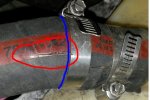I will apologize in advance....I had posted some of this before but it was deleted in the updates, I know there were some suggestions posted but I cannot get to them now.
The tank end of my fuel fill hose looks like this. There is a crack in the outer covering forming off the end of the tank bushing, at this point it looks like its just the outer covering, the inner braiding and liner is still intact. The blue line represents the end of the bushing, the red cirlce is the crack. Since this hose is not under pressure and does not have fuel sitting in it what are the opinions on replacing it now or waiting until the end of the season. It seems like it has low probability of losing fuel if it was cracked through even fuel vapor since the tank is vented and vapor would more easily escape to atmosphere through the vent. There are absolutely 0 issues with the rest of the hose back to the fill plate.
If I go to replace it, are there any tips or tricks I need to be aware of. I worked in an automotive shop for awhile and have done my fair share of hose replacements but not with plastic tanks and hardwall hose. It seems simple enough to me to remove and replace, but I donât know how tight the hose fits, how compressible it is, or if there are concerns with the plastic tank cracking or breaking during the process...sometimes even the easiest task becomes difficult if you arent prepared.
The tank end of my fuel fill hose looks like this. There is a crack in the outer covering forming off the end of the tank bushing, at this point it looks like its just the outer covering, the inner braiding and liner is still intact. The blue line represents the end of the bushing, the red cirlce is the crack. Since this hose is not under pressure and does not have fuel sitting in it what are the opinions on replacing it now or waiting until the end of the season. It seems like it has low probability of losing fuel if it was cracked through even fuel vapor since the tank is vented and vapor would more easily escape to atmosphere through the vent. There are absolutely 0 issues with the rest of the hose back to the fill plate.
If I go to replace it, are there any tips or tricks I need to be aware of. I worked in an automotive shop for awhile and have done my fair share of hose replacements but not with plastic tanks and hardwall hose. It seems simple enough to me to remove and replace, but I donât know how tight the hose fits, how compressible it is, or if there are concerns with the plastic tank cracking or breaking during the process...sometimes even the easiest task becomes difficult if you arent prepared.
Attachments
Last edited:




















